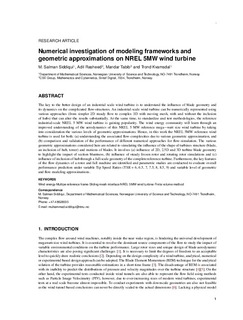| dc.contributor.author | Siddiqui, Muhammad Salman | |
| dc.contributor.author | Rasheed, Adil | |
| dc.contributor.author | Tabib, Mandar | |
| dc.contributor.author | Kvamsdal, Trond | |
| dc.date.accessioned | 2019-02-26T10:04:16Z | |
| dc.date.available | 2019-02-26T10:04:16Z | |
| dc.date.created | 2018-11-19T15:16:01Z | |
| dc.date.issued | 2018 | |
| dc.identifier.citation | Renewable Energy. 2018, 132 1058-1075. | nb_NO |
| dc.identifier.issn | 0960-1481 | |
| dc.identifier.uri | http://hdl.handle.net/11250/2587411 | |
| dc.description.abstract | The key to the better design of an industrial scale wind turbine is to understand the influence of blade geometry and its dynamics on the complicated flow-structures. An industrial-scale wind turbine can be numerically represented using various approaches (from simpler 2D steady flow to complex 3D with moving mesh, with and without the inclusion of hubs) that can alter the results substantially. At the same time, to standardize and test methodologies, the reference industrial-scale NREL 5 MW wind turbine is gaining popularity. The wind energy community will learn through an improved understanding of the aerodynamics of this NREL 5 MW reference mega-watt size wind turbine by taking into consideration the various levels of geometric approximations. Hence, in this work the NREL 5 MW reference wind turbine is used for both: (a) understanding the associated flow-complexities due to various geometric approximation, and (b) comparison and validation of the performance of different numerical approaches for flow-simulation. The various geometric approximations considered here are related to simulating the influence of the shape of turbines structure (blade, an inclusion of hub, tower) and motions of blades. It involves (a) influence of 2D, 2.5D and 3D turbine blade geometry to highlight the impact of section bluntness, (b) influence of steady frozen rotor and rotating rotor simulations and (c) influence of inclusion of hub through a full-scale geometry of the complete reference turbine. Furthermore, the key features of the flow dynamics of a rotor and full machine are identified and parametric studies are conducted to evaluate overall performance prediction under variable Tip Speed Ratios (TSR = 6, 6.5, 7, 7.5, 8, 8.5, 9) and variable level of geometric and flow modeling approximations. | nb_NO |
| dc.language.iso | eng | nb_NO |
| dc.publisher | Elsevier | nb_NO |
| dc.rights | Attribution-NonCommercial-NoDerivatives 4.0 Internasjonal | * |
| dc.rights.uri | http://creativecommons.org/licenses/by-nc-nd/4.0/deed.no | * |
| dc.title | Numerical investigation of modeling frameworks and geometric approximations on NREL 5 MW wind turbine | nb_NO |
| dc.type | Journal article | nb_NO |
| dc.type | Peer reviewed | nb_NO |
| dc.description.version | acceptedVersion | nb_NO |
| dc.source.pagenumber | 1058-1075 | nb_NO |
| dc.source.volume | 132 | nb_NO |
| dc.source.journal | Renewable Energy | nb_NO |
| dc.identifier.doi | 10.1016/j.renene.2018.07.062 | |
| dc.identifier.cristin | 1632279 | |
| dc.relation.project | Norges forskningsråd: 193823 | nb_NO |
| dc.relation.project | Norges forskningsråd: 216465 | nb_NO |
| dc.description.localcode | © 2018. This is the authors’ accepted and refereed manuscript to the article. Locked until 19.07.2020 due to copyright restrictions. This manuscript version is made available under the CC-BY-NC-ND 4.0 license http://creativecommons.org/licenses/by-nc-nd/4.0/ | nb_NO |
| cristin.unitcode | 194,63,15,0 | |
| cristin.unitname | Institutt for matematiske fag | |
| cristin.ispublished | true | |
| cristin.fulltext | postprint | |
| cristin.qualitycode | 1 | |

